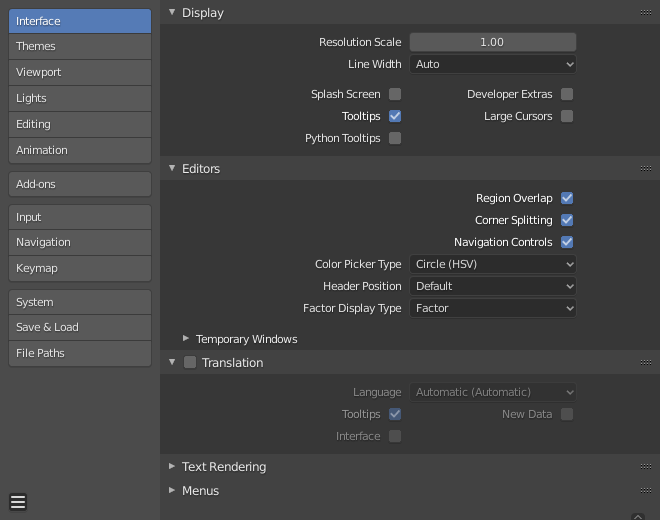Interface¶
La configuration de l’interface vous permet de modifier l’affichage des éléments de l’UI et leur façon de réagir.

Display (affichage)¶
- Resolution Scale
- Ajuste la taille des fontes et des boutons par rapport au DPI détecté automatiquement. En usage typique, il se peut que vous préfériez utiliser le zoom qui est disponible dans différents parties de l’interface de Blender.
- Line Width
Dimension des lignes et des points dans l’interface, par ex. le contour des boutons, les points des arêtes et des sommets dans la vue 3D.
Thin, Auto, Thick
- Splash Screen
- Afficher le Écran d’accueil (Splash Screen) au démarrage de Blender.
- Tooltips (infobulles)
- When enabled, a tooltip will appear when your mouse pointer is over a control. This tip explains the function of what is under the pointer, gives the associated hotkey (if any).
- Python Tooltips
- Affiche l’information Python de la propriété sous l’infobulle.
- Developer Extras
Show settings and menu items which are intended to help developers, this includes:
- Button Context Menu
- Online Python Reference
- To open the Python reference manual.
- Copy Python Command
- To copy the expression used when pressing the button.
- Edit Source
- To edit Python source code that defines the button.
- Edit Translation
- The option to edit-translations (Only when the Manage UI translations add-on is also enabled).
- 3D View
- Show Indices
- The option to show mesh vertex/edge/face indices in the overlay popover.
- Large Cursors
- Utilise les grands curseurs de souris si disponibles.
Editors¶
- Region Overlap
- This makes regions overlap the viewport. It means that the Toolbar and Sidebar regions, will be displayed overlapping the 3D Viewport.
- Corner Splitting
Split & join by dragging from the corners.
When disabled, you can use the context menu for area separators to perform these operations.
- Navigation Controls
Show navigation controls at top right of the window.
This impacts the 3D Viewport as well as image spaces.
Note
If you’re familiar with navigation key shortcuts, this can be disabled.
- Color Picker Type
Choose which type of color space you prefer. It will show when clicking LMB on any color field.
See the different color picker types at the Color picker page.
- Header Position
The default header position.
Using default uses top for most window types and the positions saved in the file. Otherwise you can choose to force top/bottom header alignment.
- Factor Display Type
How factor value types are displayed in the user interface.
- Factor
- Values are displayed as float numbers between 0.0 and 1.0.
- Percentage
- Values are expressed as a percentage between 0 and 100.
Translation¶
Blender supports a wide range of languages, enabling this checkbox will enable Blender to support International Fonts. International fonts can be loaded for the User Interface and used instead of the font bundled with Blender by default.
This will also enable options for translating the User Interface through a list of languages and tips for Blender tools which appear whenever the mouse pointer hovers over a tool button.
Blender supports I18N for internationalization. For more Information on how to load International fonts, see: Editing Texts page.
Text Rendering¶
- Anti-aliasing
- Enable interface text anti-aliasing. When disabled, texts are rendered using straight text rendering (filling only absolute pixels).
- Hinting
- Adjust font hinting, controls the spacing and crispness of text display.
- Interface Font
- Replacement for the default user interface font.
- Mono-space Font
- Replacement for the default mono-space interface font (used in the Text editor and Python Console).